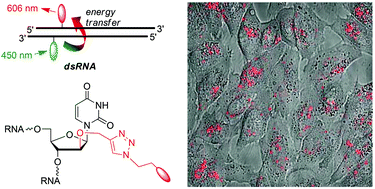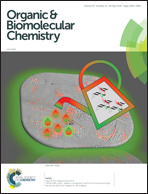“siRNA traffic lights”: arabino-configured 2′-anchors for fluorescent dyes are key for dual color readout in cell imaging†
Abstract
Two fluorescent dyes covalently attached in diagonal interstrand orientation to siRNA undergo energy transfer and thereby enable a dual color fluorescence readout (red/green) for hybridization. Three different structural variations were carried out and compared by their optical properties, including (i) the base surrogate approach with an acyclic linker as a substitute of the 2-deoxyriboside between the phosphodiester bridges, (ii) the 2′-modification of conventional ribofuranosides and (iii) the arabino-configured 2′-modification. The double stranded siRNA with the latter type of modification delivered the best energy transfer efficiency, which was explained by molecular dynamics simulations that showed that the two dyes are more flexible at the arabino-configured sugars compared to the completely stacked situation at the ribo-configured ones. Single molecule fluorescence lifetime measurements indicate their application in fluorescence cell imaging, which reveals a red/green fluorescence contrast in particular for the arabino-configured 2′-modification by the two dyes, which is key for tracking of siRNA transport into HeLa cells.

- This article is part of the themed collection: Chemical Biology in OBC


 Please wait while we load your content...
Please wait while we load your content...